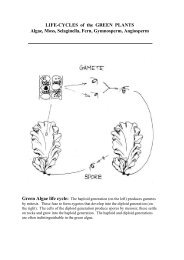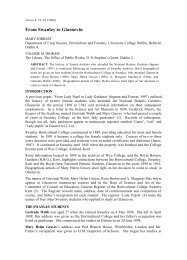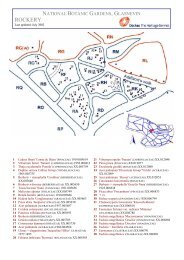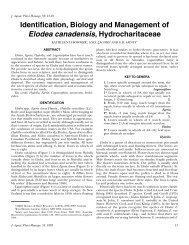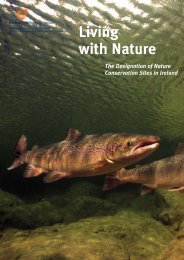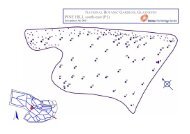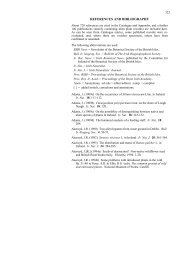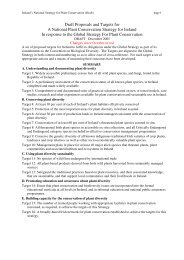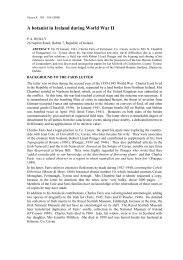Global Strategy for Plant Conservation
Global Strategy for Plant Conservation
Global Strategy for Plant Conservation
- No tags were found...
You also want an ePaper? Increase the reach of your titles
YUMPU automatically turns print PDFs into web optimized ePapers that Google loves.
<strong>Global</strong> <strong>Strategy</strong><strong>for</strong> <strong>Plant</strong> <strong>Conservation</strong>
<strong>Global</strong> <strong>Strategy</strong> <strong>for</strong><strong>Plant</strong> <strong>Conservation</strong>Published by the Secretariat of theConvention on Biological DiversityThe Secretariat of the Convention on Biological DiversityWorld Trade Centre, 393 St. Jacques, Suite 300,Montreal, Quebec, Canada H2Y 1N9Tel: +1 (514) 288-2220Fax: +1 (514) 288 6588E-mail: secretariat@biodiv.orgWebsite: http://www/biodiv/orgPublished in association with Botanic Gardens<strong>Conservation</strong> International124 56 78Photographs:1, 2, 4, 5, 6, 7 © Peter Wyse Jackson/BGCI3 © FAO photo/G. Bizzarri8 © FAO photo/R. Faidutti3Botanic Gardens <strong>Conservation</strong> InternationalDescanso House, 199 Kew Road, Richmond,Surrey TW9 3BW, U.K.Tel: +44 (0)20 8332 5953Fax: +44 (0)20 8332 5956Email: info@bgci.org.ukInternet: www.bgci.org.ukU.K. Charity Reg. No.328475Additional copies are available fromThe Secretariat of the Convention on Biological Diversityor Botanic Gardens <strong>Conservation</strong> International.
<strong>Global</strong> <strong>Strategy</strong> <strong>for</strong> <strong>Plant</strong> <strong>Conservation</strong>01Foreword<strong>Plant</strong>s are a vital part of the world’s biological diversityand an essential resource <strong>for</strong> human well-being.Besides the crop plants that provide our basic foodand fibres, many thousands of wild plants have greateconomic and cultural importance and potential,providing food, medicine, fuel, clothing and shelter <strong>for</strong>vast numbers of people throughout the world.Traditional Chinese medicine alone uses over 5,000plant species and traditional medicines in India arebased on 7,000 different plants. <strong>Plant</strong>s also play a keyrole in maintaining basic ecosystem functions and areessential <strong>for</strong> the survival of the world's animal life.Yet, despite our reliance on plants, crisis point hasbeen reached. Although much work remains to becarried out to evaluate the status of the world’s plants,it is clear that between 60,000 to 100,000 plant speciesare threatened worldwide.<strong>Plant</strong>s are endangered by a combination of factors:over-collecting, unsustainable agriculture and <strong>for</strong>estrypractices, urbanisation, pollution, land use changes,and the spread of invasive alien species and climatechange.Working through a unique partnership of internationaland national organizations, Parties, other Governmentsand NGOs, the Convention on Biological Diversity hasdeveloped — in only two years since the Gran CanariaDeclaration – a <strong>Global</strong> <strong>Strategy</strong> <strong>for</strong> <strong>Plant</strong> <strong>Conservation</strong>which was adopted unanimously at the sixth meetingof the Conference of the Parties to the Convention heldin The Hague in April, 2002 (decision VI/9). While theentry point <strong>for</strong> the <strong>Strategy</strong> is plant conservation, otheraspects such as sustainable use, benefit-sharing andcapacity building are also included.National Governments are being invited to adopt theirown targets within the framework of the <strong>Strategy</strong> andto work in a coordinated way to achieve its goals by2010.I am grateful to all of those organizations andindividuals worldwide who contributed to thedevelopment of the <strong>Global</strong> <strong>Strategy</strong> <strong>for</strong> <strong>Plant</strong><strong>Conservation</strong>. I also acknowledge the generoussupport given by Botanic Gardens <strong>Conservation</strong>International and HSBC, through the “Investing inNature” partnership, who have made it possible <strong>for</strong> the<strong>Global</strong> <strong>Strategy</strong> <strong>for</strong> <strong>Plant</strong> <strong>Conservation</strong> to be publishedin this booklet.The <strong>Strategy</strong> and its 16 targets clearly set out thechallenge <strong>for</strong> all of us. I invite you to join with us toimplement the <strong>Strategy</strong> at all levels, from local tointernational, and achieve its targets by 2010 tosafeguard the world’s plant diversity.Hamdallah ZedanExecutive SecretaryConvention on Biological DiversityThe <strong>Strategy</strong> provides an innovative framework <strong>for</strong>actions at global, regional, national and local levels.A global dimension is important because it can facilitatethe development of a consensus of key objectives,targets and actions and enhance collaboration andsynergy at all levels. The <strong>Strategy</strong> is supported by awide range of organizations and institutions –governments, intergovernmental organizations,conservation and research organizations (such asprotected-area management boards, botanic gardens,and gene banks), universities, research institutes, nongovernmentalorganizations and their networks, and theprivate sector. The most innovative element of the<strong>Strategy</strong> is the inclusion of 16 outcome-orientatedtargets, aimed at achieving a series of measurablegoals by 2010. This is the first time that such targetshave been adopted under the Convention, and thesuccess of this approach will be watched with interestas a potential model <strong>for</strong> other work programmes.
02<strong>Global</strong> <strong>Strategy</strong> <strong>for</strong> <strong>Plant</strong> <strong>Conservation</strong>Introductory NotesThe <strong>Global</strong> <strong>Strategy</strong> <strong>for</strong> <strong>Plant</strong> <strong>Conservation</strong> is presented here as approved in Decision VI/9 of theConference of the Parties (COP) to the Convention on Biological Diversity, on 19 April, 2002 in The Hague.Decision VI/9 adopting the GSPC is contained below. Readers please note that the original text of thedecision contains three parts: the recommendations, the annex containing the strategy and the appendixto the annex containing the “Terms and technical rational <strong>for</strong> the sixteen targets of the <strong>Global</strong> <strong>Strategy</strong>”.For easy reference, the terms and technical rationale of the appendix have been presented in boxes insertedunder each target of section C of the annex (page 6 to 11).Decision VI/9.Of the Conference of the Parties to theConvention on Biological Diversity on the <strong>Global</strong><strong>Strategy</strong> <strong>for</strong> <strong>Plant</strong> <strong>Conservation</strong>The Conference of the Parties1. Adopts the <strong>Global</strong> <strong>Strategy</strong> <strong>for</strong> <strong>Plant</strong> <strong>Conservation</strong>,including outcome-oriented global targets <strong>for</strong> 2010,annexed to the present decision;2. Invites relevant international and regionalorganizations to endorse the strategy and to contributeto its implementation, including to adopt these targets,in order to promote a common ef<strong>for</strong>t towards haltingthe loss of plant diversity;3. Emphasizes that the targets should be viewed as aflexible framework within which national and/or regionaltargets may be developed, according to nationalpriorities and capacities, and taking into accountdifferences in plant diversity between countries;4. Invites Parties and Governments to develop nationaland/or regional targets, and, as appropriate, toincorporate them into relevant plans, programmes andinitiatives, including national biodiversity strategies andaction plans;5. Stresses the potential role of the strategy incontributing to poverty alleviation and sustainabledevelopment;6. Emphasizes the need <strong>for</strong> capacity-building,particularly in developing countries, small islanddeveloping States, and countries with economies intransition, in order to enable them to implement thestrategy;7. Invites Parties, other Governments, the financialmechanism, and funding organizations to provideadequate and timely support to the implementation ofthe strategy, especially by developing country Parties,in particular the least developed countries and smallisland developing States among them, and Parties witheconomies in transition;8. Decides to review, at its eighth and tenth meetings,the progress made in reaching the global targets, andprovide additional guidance in light of those reviews,including, as necessary, refinement of the targets;9. Decides to consider the <strong>Global</strong> <strong>Strategy</strong> <strong>for</strong> <strong>Plant</strong><strong>Conservation</strong> as a pilot approach <strong>for</strong> the use ofoutcome targets under the Convention within thecontext of the Strategic Plan and, also consider thewider application of this approach to other areas underthe Convention, including other taxonomic groups;10. Requests the Subsidiary Body on Scientific,Technical and Technological Advice:(a) To take the targets into consideration in itsperiodic reviews of the thematic and crosscuttingprogrammes of work of the Convention;(b) To develop ways and means, within theConvention’s thematic and cross-cuttingprogrammes of work, <strong>for</strong> promotingimplementation of the global strategy <strong>for</strong> plantconservation, and <strong>for</strong> monitoring and assessingprogress; and to report to the Conference of theParties at its seventh meeting;11. Welcomes the contribution of the “Gran CanariaGroup” in developing this <strong>Strategy</strong>, and invite theorganizations involved, and other relevantorganizations, in collaboration with the ExecutiveSecretary, to contribute to the further development,implementation and monitoring of the <strong>Strategy</strong>.
<strong>Global</strong> <strong>Strategy</strong> <strong>for</strong> <strong>Plant</strong> <strong>Conservation</strong>03Annex<strong>Global</strong> <strong>Strategy</strong> <strong>for</strong> <strong>Plant</strong> <strong>Conservation</strong>A. ObjectivesAs many as two-third of theworld's plant species are indanger of extinction in natureduring the course of the 21stcentury, threatened bypopulation growth,de<strong>for</strong>estation, habitat loss,destructive development, overconsumption of resources, thespread of alien invasive speciesand agricultural expansion.Further loss of plant diversityis predicted through geneticerosion and narrowing of thegenetic basis of many species.Gran Canaria Declaration,2000The ecosystem approachThe ecosystem approach is astrategy <strong>for</strong> the integratedmanagement of land, waterand living resources thatpromotes conservation andsustainable use in an equitableway. Application of theecosystem approach helps toreach a balance of the threeobjectives of the Convention,which are the conservation ofbiological diversity, thesustainable use of itscomponents and the fair andequitable sharing of thebenefits arising out of theutilization of genetic resources.It is based on the applicationof appropriate scientificmethodologies focused onlevels of biologicalorganization which encompassthe essential processes,functions and interactionsamong organisms and theirenvironment. It recognizes thathumans, with their culturaldiversity, are an integralcomponent of ecosystems. Asdescribed by the Conference ofthe Parties, the ecosystemapproach is the primaryframework <strong>for</strong> action underthe Convention.1. The ultimate and long-term objective of the <strong>Global</strong> <strong>Strategy</strong> <strong>for</strong> <strong>Plant</strong><strong>Conservation</strong> is to halt the current and continuing loss of plant diversity.2. The <strong>Strategy</strong> will provide a framework to facilitate harmony between existinginitiatives aimed at plant conservation, to identify gaps where new initiatives arerequired, and to promote mobilization of the necessary resources.3. The <strong>Strategy</strong> will be a tool to enhance the ecosystem approach to theconservation and sustainable use of biodiversity and focus on the vital role of plantsin the structure and functioning of ecological systems and assure provision of thegoods and services such systems provide.4. The <strong>Strategy</strong> will also:(a) Provide a pilot exercise under the Convention <strong>for</strong> the setting of targets that relateto ultimate objectives of the Convention;(b) Act as a means to develop and implement the thematic programmes of work ofthe Convention.5. Within the ultimate and long-term objective, a number of sub-objectives can beidentified as follows:(a) Understanding and documenting plant diversity:(i) Document the plant diversity of the world, including its use and its distribution inthe wild, in protected areas and in ex situ collections;(ii) Monitor the status and trends in global plant diversity and its conservation, andthreats to plant diversity, and identify plant species, plant communities, andassociated habitats and ecosystems, at risk, including consideration of “red lists”;(iii) Develop an integrated, distributed, interactive in<strong>for</strong>mation system to manageand make accessible in<strong>for</strong>mation on plant diversity;(iv) Promote research on the genetic diversity, systematics, taxonomy, ecology andconservation biology of plants and plant communities, and associated habitats andecosystems, and on social, cultural and economic factors that impact biodiversity,so that plant diversity, both in the wild and in the context of human activities, canbe well understood and utilized to support conservation action;(b) Conserving plant diversity:Improve long-term conservation, management and restoration of plant diversity, plantcommunities, and the associated habitats and ecosystems, in situ (both in morenatural and in more managed environments), and, where necessary to complement insitu measures, ex situ, preferably in the country of origin. The <strong>Strategy</strong> will pay specialattention to the conservation of the world’s important areas of plant diversity, and tothe conservation of plant species of direct importance to human societies;
04<strong>Global</strong> <strong>Strategy</strong> <strong>for</strong> <strong>Plant</strong> <strong>Conservation</strong>The significance ofmeasurable targetsWorldwide there is anincreasing trend towards theincorporation of measurableoutcome targets into strategiesand other plans adopted <strong>for</strong>biodiversity conservation.Probably the best knownexample is the United NationsMillennium DevelopmentGoals which have beenadopted by many countries,both donors and developingcountries.Thematic programmes of workof the CBDThe Conference of the Partiesto the Convention has initiatedfive thematic workprogrammes, addressingmarine and coastalbiodiversity, agriculturalbiodiversity, <strong>for</strong>est biodiversity,the biodiversity of inlandwaters, and dry and subhumidlands. Each thematicprogramme establishes a vision<strong>for</strong>, and basic principles toguide, future work; sets outkey issues <strong>for</strong> consideration;identifies potential outputs;and suggests a timetable andmeans <strong>for</strong> achieving theseoutputs.(c) Using plant diversity sustainably:(i) Strengthen measures to control unsustainable utilization of plant resources;(ii) Support the development of livelihoods based on sustainable use of plants, andpromote the fair and equitable sharing of benefits arising from the use of plantdiversity;(d) Promoting education and awareness about plant diversity:Articulate and emphasize the importance of plant diversity, the goods and servicesthat it provides, and the need <strong>for</strong> its conservation and sustainable use, in order tomobilize necessary popular and political support <strong>for</strong> its conservation andsustainable use;(e) Building capacity <strong>for</strong> the conservation of plant diversity:(i) Enhance the human resources, physical and technological infrastructurenecessary, and necessary financial support <strong>for</strong> plant conservation;(ii) Link and integrate actors to maximize action and potential synergies in supportof plant conservation.B. Rationale, scope and general principles6. <strong>Plant</strong>s are universally recognized as a vital part of the world’s biological diversityand an essential resource <strong>for</strong> the planet. In addition to the small number of cropplants used <strong>for</strong> basic food and fibres, many thousands of wild plants have greateconomic and cultural importance and potential, providing food, medicine, fuel,clothing and shelter <strong>for</strong> vast numbers of people throughout the world. <strong>Plant</strong>s play akey role in maintaining the planet's basic environmental balance and ecosystemstability and provide an important component of the habitats <strong>for</strong> the world's animallife. At present, a complete inventory of the plants of the world has not beenassembled, but it is estimated that the total number of vascular plant species maybe of the order of 300,000. Of particular concern is the fact that many are in dangerof extinction, threatened by habitat trans<strong>for</strong>mation, over-exploitation, alien invasivespecies, pollution and climate change. The disappearance of such vital and largeamounts of biodiversity sets one of the greatest challenges <strong>for</strong> the worldcommunity: to halt the destruction of the plant diversity that is so essential to meetthe present and future needs of humankind. The <strong>Global</strong> <strong>Strategy</strong> <strong>for</strong> <strong>Plant</strong><strong>Conservation</strong> is proposed to address this challenge. While the entry point <strong>for</strong> the<strong>Strategy</strong> is conservation, aspects of sustainable use and benefit-sharing are alsoincluded.7. The rationale <strong>for</strong> a strategy focusing on plants has two aspects:(a) <strong>Plant</strong>s are primary producers and provide habitat infrastructure <strong>for</strong> manyecosystems;(b) Setting meaningful targets is feasible since scientific understanding of at leasthigher plants, though incomplete, is better than <strong>for</strong> most other groups.8. Accordingly, the <strong>Strategy</strong> addresses the <strong>Plant</strong> Kingdom with focus on higherplants, and other well-described groups such as Bryophytes and Pteridophytes.The setting of measurable targets <strong>for</strong> this set of taxa is more credible than <strong>for</strong> manylower plant groups. This does not imply that these groups do not have important
<strong>Global</strong> <strong>Strategy</strong> <strong>for</strong> <strong>Plant</strong> <strong>Conservation</strong>05The Bonn GuidelinesThe Bonn Guidelines on accessto genetic resources and thefair and equitable sharing ofthe benefits arising from theirutilization were adopted byCOP VI of the Convention(decision VI/24). They arerecognized as a useful first stepof an evolutionary process inthe implementation of relevantprovisions of the Conventionin this area and provideguidance also on such issues astraditional knowledge andtechnology transfer. Thevoluntary guidelines are aimedat assisting Parties, otherGovernments and otherstakeholders to develop anoverall access and benefitsharingstrategy, and inidentifying the steps involvedin the process of obtainingaccess to genetic resources andbenefit-sharing. They are alsoto provide assistance whenlegislative, administrative orpolicy measures on access andbenefit-sharing are beingestablished and/or whennegotiating contractualarrangements <strong>for</strong> access andbenefit-sharing.Article 8(j) of theConvention states:Each Contracting Party shall,as far as possible and asappropriate, subject to itsnational legislation, respect,preserve and maintainknowledge, innovations andpractices of indigenous andlocal communities embodyingtraditional lifestyles relevant<strong>for</strong> the conservation andsustainable use of biologicaldiversity and promote theirwider application with theapproval and involvement ofthe holders of such knowledge,innovations and practices andencourage the equitablesharing of the benefits arisingfrom the utilization of suchknowledge, innovations andpractices.Article 10(c) of theConvention states:Each Contracting Party shall,as far as possible and asappropriate: Protect andencourage customary use ofbiological resources inaccordance with traditionalcultural practices that arecompatible with conservationor sustainable userequirements.ecological functions, nor that they are not threatened. However, effective action willbe best achieved by focusing, in an initial phase at least, on achievable outcomes<strong>for</strong> known taxa. Parties may choose on a national basis to include lower taxa.9. The <strong>Strategy</strong> applies to plant genetic diversity, plant species and communitiesand their associated habitats and ecosystems.10. The <strong>Strategy</strong> would provide a framework <strong>for</strong> actions at global, regional, nationaland local levels. A global dimension to the <strong>Strategy</strong> is important because it can:(a) Facilitate the development of a global consensus of key objectives, targets andactions;(b) Strengthen possibility of implementing necessary transnational actions (such assome recovery programmes);(c) Optimize availability and usefulness of in<strong>for</strong>mation;(d) Be used to focus research on key generic issues (such as conservationmethods);(e) Allow the identification of appropriate standards <strong>for</strong> plant conservation;(f) Mobilize support <strong>for</strong> globally significant actions (globally threatened species;“centres of plant diversity” and “hot spots”); and(g) Allow <strong>for</strong> collaboration between national, regional and international entities.11. The <strong>Global</strong> <strong>Strategy</strong> <strong>for</strong> <strong>Plant</strong> <strong>Conservation</strong> will:(a) Apply the Convention provisions on access and benefit-sharing, drawing asappropriate on the Bonn Guidelines <strong>for</strong> access and benefit-sharing, with a view toensuring a fair and equitable sharing of benefits arising from the use of geneticresources, and consistent with the International Treaty on <strong>Plant</strong> Genetic Resources<strong>for</strong> Food and Agriculture;(b) Build upon the knowledge, innovations and practices of indigenous and localcommunities, with the approval and involvement of the holders of such knowledge,innovations and practices, and contribute to the implementation of Article 8(j) of theConvention;(c) Apply the ecosystem approach adopted under the Convention, recognizing theinteraction of plants and plant communities, with other components of ecosystems,at all scales, and their role in ecosystem functions and processes. The ecosystemapproach also implies, inter alia, intersectoral cooperation, decentralization ofmanagement to the lowest level appropriate, equitable distribution of benefits, andthe use of adaptive management policies that can deal with uncertainties and aremodified in the light of experience and changing conditions;(d) Employ in situ conservation measures as the primary approach <strong>for</strong> conservation,complementing them where necessary with ex situ measures. The <strong>Strategy</strong> providesan opportunity to explore linkages between in situ and ex situ conservation,including in restoration programmes.(e) Adopt a multidisciplinary approach that takes into account scientific, social andeconomic issues;(f) Strengthen initiatives on national inventories.
06<strong>Global</strong> <strong>Strategy</strong> <strong>for</strong> <strong>Plant</strong> <strong>Conservation</strong>C. Targets12. The global targets <strong>for</strong> the year 2010 are as follows, and their terms and technicalrationale are appended to the present <strong>Strategy</strong>: The date of 2010 has been used tosynchronize the <strong>Strategy</strong> with the Convention’s Strategic Plan.(a) Understanding and documenting plant diversity:(i) A widely accessible working list of known plant species, as a steptowards a complete world flora;Some 900,000 scientificnames are used <strong>for</strong> 270,000known plant speciesTerms and technical rationaleA working list of known plant species is considered to be a fundamental requirement <strong>for</strong>plant conservation. The target is considered to be attainable by 2010, especially giventhat is to be a working rather than a definitive list, and it is limited to known organisms(currently about 270,000, which may increase by 10 – 20% by 2010). Some 900,000scientific names are known <strong>for</strong> these 270,000 species. In effect the target will require thecompilation and synthesis of existing knowledge, focusing on names and synonyms, andgeographical distribution. Both national flora and compilations and international initiativesare important in this respect. The list could be made accessible through the World WideWeb, complemented by CD-ROM and printed versions. Further work on national andregional floras is necessary to lay the basis <strong>for</strong> the longer term aim of developing acomplete world flora, including local and vernacular names.(ii) A preliminary assessment of the conservation status of all known plantspecies, at national, regional and international levels;34,000 plant species areclassified as globallythreatened with extinctionTerms and technical rationaleOver 60,000 species have been evaluated <strong>for</strong> conservation status according tointernationally accepted criteria, of which 34,000 are classified as globally threatenedwith extinction (IUCN, 1997). In addition, many countries have assessed theconservation status of their own floras. There are currently about 270,000 knownspecies. Of those still to be evaluated, sufficient in<strong>for</strong>mation <strong>for</strong> a full assessment is onlyavailable <strong>for</strong> a proportion. Thus, only a preliminary assessment will have been carried outon the remaining, “data-deficient” species. Subsequently, further fieldwork will beessential to enable more comprehensive assessments to be undertaken.(iii) Development of models with protocols <strong>for</strong> plant conservation andsustainable use, based on research and practical experience;Terms and technical rationale<strong>Conservation</strong> biology research, and methodologies and practical techniques <strong>for</strong>conservation are fundamental to the conservation of plant diversity and the sustainableuse of its components. These can be applied through the development and effectivedissemination of relevant models and protocols <strong>for</strong> applying best practice, based on theresults of existing and new research and practical experience of management.‘Protocols’ in this sense, can be understood as practical guidance on how to conductplant conservation and sustainable use activities in particular settings. Key areas wherethe development of models with protocols is required include: the integration of in situand ex situ conservation; maintenance of threatened plants within ecosystems; applyingthe ecosystem approach; balancing sustainable use with conservation; andmethodologies <strong>for</strong> setting conservation priorities; and methodologies <strong>for</strong> monitoringconservation and sustainable use activities.
<strong>Global</strong> <strong>Strategy</strong> <strong>for</strong> <strong>Plant</strong> <strong>Conservation</strong>07(b) Conserving plant diversity:(iv) At least 10 per cent of each of the world’s ecological regionseffectively conserved;Natural grasslands (such asprairies) and coastal andestuarine ecosystems,including mangroves, arepoorly represented inprotected areasTerms and technical rationaleAbout 10% of the land surface is currently covered by protected areas. In general,<strong>for</strong>ests and mountain areas are well represented in protected areas, while naturalgrasslands (such as prairies) and coastal and estuarine ecosystems, includingmangroves, are poorly represented. The target would imply: (i) increasing therepresentation of different ecological regions in protected areas, and (ii) increasing theeffectiveness of protected areas. Since some ecological regions will include protectedareas covering more than 10% of their area, the qualifier “at least” is used. In somecases, ecosystems restoration and rehabilitation may be necessary. Effectiveconservation is understood to mean that the area is managed to achieve a favorableconservation status <strong>for</strong> plant species and communities. Various approaches are available<strong>for</strong> use in the identification of ecological regions, based on major vegetation types.Further targets may be agreed in the future.(v) Protection of 50 per cent of the most important areas <strong>for</strong> plantdiversity assured;Terms and technical rationaleThe most important areas <strong>for</strong> plant diversity would be identified according to the criteriaincluding endemism, species richness, and/or uniqueness of habitats, including relictecosystems, also taking into account the provision of ecosystem services. They wouldbe identified primarily at local and national levels. Protection would be assured througheffective conservation measures, including protected areas. Experience from regionalinitiatives on important plant areas, as well as a similar approach on important bird areassuggests that 50% is a realistic target <strong>for</strong> 2010. In the longer term the protection of allimportant plant areas should be assured.(vi) At least 30 per cent of production lands managed consistent with theconservation of plant diversity;Terms and technical rationaleFor the purpose of the target, production lands refer to lands where the primary purposeis agriculture (including horticulture), grazing, or wood production. Consistent withconservation of plant diversity implies that a number of objectives are integrated into themanagement of such production lands: <strong>Conservation</strong> of plant diversity which is anintegral part of the production system itself (i.e., crop, pasture or tree species andgenetic diversity); Protection of other plant species in the production landscape that areunique, threatened, or of particular socio-economic value; Use of managementpractices that avoid significant adverse impacts on plant diversity in surroundingecosystems, <strong>for</strong> example by avoiding excessive release of agro-chemicals andpreventing unsustainable soil erosion.2. Increasingly, integrated production methods are being applied in agriculture, includingintegrated pest management, conservation agriculture, and on-farm management ofplant genetic resources. Similarly, sustainable <strong>for</strong>est management practices are beingmore broadly applied. Against this background, and with the above understanding of theterms used, the target is considered feasible. Higher targets are appropriate <strong>for</strong> naturalor semi-natural <strong>for</strong>ests and grasslands.
08<strong>Global</strong> <strong>Strategy</strong> <strong>for</strong> <strong>Plant</strong> <strong>Conservation</strong>(vii) 60 per cent of the world’s threatened species conserved in situ;Terms and technical rationaleConserved in situ is here understood to mean that populations of the species are effectivelymaintained in at least one protected area or through other in situ management measures.In some countries this figure has already been met, but it would require additional ef<strong>for</strong>ts inmany countries. The target should be seen as a step towards the effective in situconservation of all threatened species.(viii) 60 per cent of threatened plant species in accessible ex situ collections,preferably in the country of origin, and 10 per cent of them included inrecovery and restoration programmes;It is estimated thatcurrently, some 30% ofknown threatened speciesare maintained in livingcollections while 2% ofthreatened species areincluded in recovery andrestoration programmes.A target of 10% isrecommended.Terms and technical rationaleCurrently, over 10,000 threatened species are maintained in living collections (botanicgardens, seed banks, and tissue culture collections), representing some 30% of knownthreatened species. It is considered that this could be increased to meet the proposedtarget by 2010, with additional resources, technology development and transfer, especially<strong>for</strong> species with recalcitrant seeds. Within this target it is suggested that priority be given tocritically endangered species, <strong>for</strong> which a target of 90% should be attained. It is estimatedthat currently about 2% of threatened species are included in recovery and restorationprogrammes. Against this baseline, a target of 10% is recommended.(ix) 70 per cent of the genetic diversity of crops and other major socioeconomicallyvaluable plant species conserved, and associated indigenousand local knowledge maintained;For some 200–300 crops, itis expected that 70% ofgenetic diversity is alreadyconserved ex situ in genebanks.Terms and technical rationaleTheory and practice demonstrate that, with an appropriate strategy, 70% of the geneticdiversity of a crop can be contained in a relatively small sample (generally, less than onethousand accessions). For any one species, there<strong>for</strong>e, the target is readily attainable. Forsome 200–300 crops, it is expected that 70% of genetic diversity is already conserved exsitu in gene banks. Genetic diversity is also conserved through on farm management. Byworking with local communities, associated indigenous and local knowledge can also bemaintained. Combining genebank, on farm, and other in situ approaches, the target couldbe reached <strong>for</strong> all crops in production, as well as major <strong>for</strong>age and tree species. Other majorsocioeconomically important species, such as medicinal plants, could be selected on acase-by-case basis, according to national priorities. Through the combined actions ofcountries, some 2,000 or 3,000 species could be covered in all.(x) Management plans in place <strong>for</strong> at least 100 major alien species thatthreaten plants, plant communities and associated habitats and ecosystems;Terms and technical rationaleThere is no agreed reliable estimate of the number of alien species that threaten indigenousplants, plant communities and associated habitats and ecosystems to such an extent thatthey may be considered as “major”. It is recommended there<strong>for</strong>e that the target beestablished <strong>for</strong> an absolute number of such major invasive alien species. The wording “Atleast 100” is considered appropriate. The 100 invasive alien species would be selected onthe basis of national priorities, also taking into account their significance at regional andglobal levels. For many alien species, it is expected that different management plans will berequired in different countries in which they threaten plants, plant communities andassociated habitats and ecosystems. This target would be considered as a first steptowards developing management plans <strong>for</strong> all major alien species that threaten plants, plantcommunities and associated habitats and ecosystems.
<strong>Global</strong> <strong>Strategy</strong> <strong>for</strong> <strong>Plant</strong> <strong>Conservation</strong>09(c) Using plant diversity sustainably:(xi) No species of wild flora endangered by international trade;Terms and technical rationaleThe proposed <strong>for</strong>mulation of the target is more precise since it focuses on those speciesthat are actually threatened by international trade. So <strong>for</strong>mulated, the target is attainableand is complementary to target 12. Species of wild flora endangered by internationaltrade include but are not limited to species listed on appendix 1 of the Convention onInternational Trade in Endangered Species of Wild Fauna and Flora (CITES). The target isconsistent with the main purpose of the CITES Strategic Plan (to 2005): "No species ofwild flora subject to unsustainable exploitation because of international trade".(xii) 30 per cent of plant-based products derived from sources that aresustainably managed;Terms and technical rationale1. <strong>Plant</strong>-based products include food products, timber, paper and other wood-basedproducts, other fibre products, and ornamental, medicinal and other plants <strong>for</strong>direct use.2. Sources that are sustainably managed are understood to include:• Natural or semi-natural ecosystems that are sustainably managed (by avoidingoverharvesting of products, or damage to other components of the ecosystem),excepting that commercial extraction of resources from some primary <strong>for</strong>estsand near-pristine ecosystems of important conservation value might beexcluded.• Sustainably managed, plantation <strong>for</strong>ests and agricultural lands.3. In both cases, sustainable management should be understood to integrate socialand environmental considerations, such as the fair and equitable sharing of benefitsand the participation of indigenous and local communities.4. Indicators <strong>for</strong> progress might include:• Direct measures e.g.: products meeting relevant verified standards (such as <strong>for</strong>organic food, certified timber, and intermediate standards that codify goodpractices <strong>for</strong> sustainable agriculture and <strong>for</strong>estry);• Indirect measures e.g.: products from sources considered to be sustainable, ornearsustainable, on the basis of farming system analyses, taking into accountthe adoption of integrated production methods. Assessment of progress will beassisted by the development of criteria and indicators of sustainable agriculturaland <strong>for</strong>est management.5. Certified organic foods and timber currently account <strong>for</strong> about 2% of productionglobally. For several product categories, examples exist of 10–20% of productsmeeting intermediate standards. Against this baseline, the target is considered to beattainable. It would be applied to each category of plant-based products,understanding that <strong>for</strong> some categories it will be more difficult to reach and moredifficult to monitor progress. Implementation would require a combination ofproduct-specific and sectorwide approaches, consistent with the Convention’sprogramme of work on agricultural biodiversity.
10<strong>Global</strong> <strong>Strategy</strong> <strong>for</strong> <strong>Plant</strong> <strong>Conservation</strong>(xiii) The decline of plant resources, and associated indigenous and localknowledge, innovations and practices that support sustainablelivelihoods, local food security and health care, halted;“ensure that current trendsin the loss of environmentalresources are effectivelyreversed at both global andnational levels by 2015”.Terms and technical rationale<strong>Plant</strong> diversity underpins livelihoods, food security and health care. This target isconsistent with one of the widely agreed international development targets, namely to“ensure that current trends in the loss of environmental resources are effectively reversedat both global and national levels by 2015”. It is recommended feasible to halt thedecline by 2010 and subsequently to reverse the decline. Relevant plant resources andmethods to address their decline are largely site specific and thus implementation mustbe locally driven. The scope of the target is understood to encompass plant resourcesand associated ethnobotanical knowledge. Measures to address the decline inassociated indigenous and local knowledge should be implemented consistent with theConvention’s programme of work on Article 8(j) and related provisions.(d) Promoting education and awareness about plant diversity:(xiv) The importance of plant diversity and the need <strong>for</strong> its conservationincorporated into communication, educational and public -awarenessprogrammes;Communication, educationand the raising of publicawareness about theimportance of plantdiversity are crucial <strong>for</strong> theachievement of all thetargets of the strategy.Terms and technical rationaleCommunication, education and the raising of public awareness about the importance ofplant diversity are crucial <strong>for</strong> the achievement of all the targets of the strategy. This targetis understood to refer to both in<strong>for</strong>mal and <strong>for</strong>mal education at all levels, includingprimary, secondary and tertiary education. Key target audiences include not only childrenand other students, but also policy-makers and the public in general. Considerationshould be given to developing specific indicators to monitor progress towardsachievement of the overall target. It may be helpful to develop indicators <strong>for</strong> specifictarget audiences. Given the strategic importance of education about plant conservation,this issue should be included not only in environmental curricula, but should also beincluded in broader areas of mainstream education policy.
<strong>Global</strong> <strong>Strategy</strong> <strong>for</strong> <strong>Plant</strong> <strong>Conservation</strong>11(e) Building capacity <strong>for</strong> the conservation of plant diversity:(xv) The number of trained people working with appropriate facilities inplant conservation increased, according to national needs, to achieve thetargets of this <strong>Strategy</strong>;It is likely that the numberof trained people workingin plant conservationworld-wide will need todouble by 2010.Terms and technical rationaleThe achievement of the targets included in the <strong>Strategy</strong> will require very considerablecapacity building, particularly to address the need <strong>for</strong> conservation practitioners trainedin a range of disciplines, with access to adequate facilities. In addition to trainingprogrammes, the achievement of this target will require long-term commitment tomaintaining infrastructure. “Appropriate facilities” are understood to include adequatetechnological, institutional and financial resources. Capacity-building should be based onnational needs assessments. It is likely that the number of trained people working inplant conservation world-wide will need to double by 2010. Given the currentgeographical disparity between biodiversity and expertise, this is likely to involveconsiderably more than a doubling of capacity in many developing countries, smallisland developing States and countries with economies in transition. Increased capacityshould be understood to include not only in-service training, but also the training ofadditional staff and other stakeholders, particularly at the community level.(xvi) Networks <strong>for</strong> plant conservation activities established orstrengthened at national, regional and international levels.Terms and technical rationaleNetworks can enhance communication and provide a mechanism to exchangein<strong>for</strong>mation, knowhow and technology. Networks will provide an important component inthe coordination of ef<strong>for</strong>t among many stakeholders <strong>for</strong> the achievement of all thetargets of the strategy. They will also help to avoid duplication of ef<strong>for</strong>t and to optimisethe efficient allocation of resources. Effective networks provide a means to developcommon approaches to plant conservation problems, to share policies and priorities andto help disseminate the implementation of all such policies at different levels. They canalso help to strengthen links between different sectors relevant to conservation, e.g. thebotanical, environmental, agricultural, <strong>for</strong>est and educational sectors. Networks providean essential link between on-the-ground conservation action and coordination,monitoring and policy development at all levels. This target is understood to include thebroadening of participation in existing networks, as well as the establishment, wherenecessary, of new networks.13. These targets provide a framework <strong>for</strong> policy <strong>for</strong>mulation and a basis <strong>for</strong>monitoring. National targets developed within this framework may vary from countryto country, according to national priorities and capacities taking into accountdifferences in plant diversity.
12<strong>Global</strong> <strong>Strategy</strong> <strong>for</strong> <strong>Plant</strong> <strong>Conservation</strong>D. The <strong>Strategy</strong> as a framework14. The <strong>Strategy</strong> is not intended to be a “programme of work” analogous to existingthematic and cross-cutting programmes of work under the Convention. It does not,there<strong>for</strong>e, contain detailed activities, expected outputs, etc. Rather, the <strong>Strategy</strong>provides a framework by means of setting outcome-orientated targets (these differfrom the “process” targets used so far under the Convention). It is envisaged that theactivities necessary to reach those targets could be developed within this framework.In many cases, activities are already under way, or envisaged in existing initiatives.These include:(a) Activities aimed at plant conservation within national biodiversity strategies andaction plans and relevant sectoral and cross-sectoral plans, programmes and policies.In this respect, Parties and Governments may wish to report on the incorporation ofthe <strong>Strategy</strong> in their national plans, programmes and policies;(b) Relevant activities under existing relevant initiatives, in particular• the Strategic Plan and work of the <strong>Plant</strong>s Committee of the Convention onInternational Trade in Endangered Species of Wild Fauna and Flora (CITES);• the International <strong>Plant</strong> Protection Convention (IPPC);• the International Treaty on <strong>Plant</strong> Genetic Resources of the Food and AgricultureOrganization;• the Berne Convention on the <strong>Conservation</strong> of European Wildlife and Natural Habitats;• the FAO <strong>Global</strong> Plan of Action <strong>for</strong> <strong>Plant</strong> Genetic Resources <strong>for</strong> Food and Agriculture;• the Man and the Biosphere programme of the United Nations Educational,Scientific Cultural Organization (UNESCO);• the <strong>Global</strong> <strong>Strategy</strong> on Invasive Alien Species of the <strong>Global</strong> Invasive SpeciesProgramme (GISP);• the plant conservation programme of the IUCN Species Survival Commission;• the International Agenda <strong>for</strong> Botanic Gardens in <strong>Conservation</strong>;• activities of the International Association of Botanic Gardens;• the WWF-UNESCO people and plant programme,• and regional strategies such as the European <strong>Plant</strong> <strong>Conservation</strong> <strong>Strategy</strong> of theCouncil of Europe and <strong>Plant</strong>a Europa;and(c) Relevant activities under the programmes of work of the Convention on BiologicalDiversity, including those relating to agricultural biodiversity, <strong>for</strong>est biological diversity,inland water biological diversity, marine and coastal biological diversity, and dry andsub-humid lands, as well as activities involving cross-cutting issues such as accessand benefit-sharing, sustainable use, indicators, alien species, the <strong>Global</strong> TaxonomyInitiative, and issues related to Article 8(j).15. The <strong>Strategy</strong> and its 16 targets are intended to provide a framework <strong>for</strong> policymakers and public opinion and catalyse the re<strong>for</strong>ms necessary to achieve plantconservation. Clear, stable, long-term targets that are adopted by the internationalcommunity can help shape expectations and create the conditions in which all actors,whether Governments, the private sector, or civil society, have the confidence todevelop solutions to address threats to plant diversity. For the targets to be widelyunderstood, and appealing to public opinion, they need to be kept fairly simple andstraight<strong>for</strong>ward. They should be understood in a commonsensical rather than a literalway. In order that the number of targets be kept manageable, they need to focus on aset of activities that are strategic, rather than aiming to be comprehensive. Targetsmay be reviewed, and appropriate revised, as major new scientific evidence becomesavailable on important areas <strong>for</strong> plant diversity, threats to diversity, and major alienspecies that threaten plants, plant communities and associated habitats andecosystems.
<strong>Global</strong> <strong>Strategy</strong> <strong>for</strong> <strong>Plant</strong> <strong>Conservation</strong>13E. Further work required to develop andimplement the <strong>Strategy</strong>16. Measures to implement the <strong>Strategy</strong> will need to be put in place at international,national, and subnational levels. This will include development of national targetsand their incorporation into relevant plans, programmes and initiatives, includingnational biodiversity strategies and action plans. National targets will vary fromcountry to country according to differences in levels of plant diversity and nationalpriorities. Multilateral and bilateral funding agencies should consider putting in placepolicies and procedures to ensure that their funding activities are supportive of anddo not run counter to the strategy and its targets.17. For each target, the scope of activities may need to be clarified and sub-targets,or milestones, developed. In order to monitor progress towards achieving thetargets, baseline data and a series of indicators may need to be developed. Thiswould draw upon relevant national and international data sets (such as national "redlists"), and make full use of the clearing-house mechanism.18. Regional components of the <strong>Strategy</strong> might be developed, perhaps using abiogeographical approach.19. In addition to the Parties to the Convention, the design, development andimplementation of the strategy should involve a range of actors, including:(a) International initiatives (e.g., intergovernmental organizations, United Nationsagencies, multilateral aid agencies);(b) <strong>Conservation</strong> and research organizations (including protected-areamanagement boards, botanic gardens, gene banks, universities, researchinstitutes, non-governmental organizations and networks of non-governmentalorganizations);(c) Communities and major groups (including indigenous and local communities,farmers, women, youth);(d) Governments (central, regional, local authorities);(e) The private sector.20. In order to promote implementation of the strategy and facilitate cooperationbetween these initiatives, the Executive Secretary will collaborate with relevantstakeholders. To ensure full participation, the actors mentioned in paragraph 19above should reflect not only United Nations geographical regions but alsobiogeographical regions. This collaboration will aim at avoiding duplication of ef<strong>for</strong>t,promote collaboration and synergies among existing initiatives, and facilitateanalysis of the status, trends, and effectiveness of different measures on theconservation and sustainable use of plant diversity. Consideration might also begiven to the establishment of a flexible coordination mechanism.
ISBN 0 9539141 5 1Supported throughInvesting in Nature; a partnership betweenBGCI, Earthwatch, HSBC and WWFInternet: http://www.investinginnature.org



